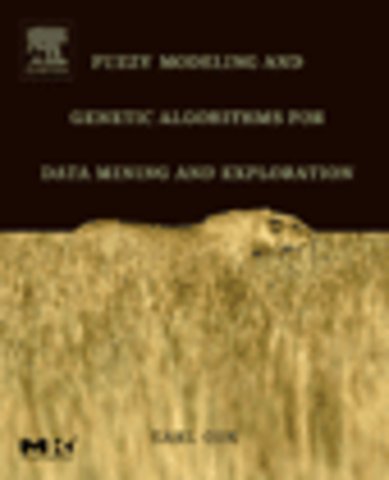


Earl Cox founded and serves as President of, Scianta Intelligence, a next generation machine intelligence and knowledge exploration company.
Meer over Earl CoxFuzzy Modeling and Genetic Algorithms for Data Mining and Exploration
Samenvatting
OP=OP
'Fuzzy Modeling and Genetic Algorithms for Data Mining and Exploration' is a handbook for analysts, engineers, and managers involved in developing data mining models in business and government. As you'll discover, fuzzy systems are extraordinarily valuable tools for representing and manipulating all kinds of data, and genetic algorithms and evolutionary programming techniques drawn from biology provide the most effective means for designing and tuning these systems.
You don't need a background in fuzzy modeling or genetic algorithms to benefit, for this book provides it, along with detailed instruction in methods that you can immediately put to work in your own projects. The author provides many diverse examples and also an extended example in which evolutionary strategies are used to create a complex scheduling system.
Features & Benefits:
- Written to provide analysts, engineers, and managers with the background and specific instruction needed to develop and implement more effective data mining systems.
- Helps you to understand the trade-offs implicit in various models and model architectures.
- Provides extensive coverage of fuzzy SQL querying, fuzzy clustering, and fuzzy rule induction.
- Lays out a roadmap for exploring data, selecting model system measures, organizing adaptive feedback loops, selecting a model configuration, implementing a working model, and validating the final model.
- In an extended example, applies evolutionary programming techniques to solve a complicated scheduling problem.
- Presents examples in C, C++, Java, and easy-to-understand pseudo-code.
- Extensive online component, including sample code and a complete data mining workbench.
Specificaties
Inhoudsopgave
Acknowledgements
Introduction
PART 1: CONCEPTS AND ISSUES
Chapter 1. FOUNDATIONS AND IDEAS
1.1. Enterprise Applications and Analysis Models
1.2. Distributed and Centralized Repositories
1.3. The Age of Distributed Knowledge
1.4. Information and Knowledge Discovery
1.5. Data Mining and Business Models
1.6. Fuzzy Systems for Business Process Models
1.7. Evolving Distributed Fuzzy Models
1.8 .A Sample Case - Evolving a Model for Customer Segmentation
1.9. Review
Chapter 2. PRINCIPAL MODEL TYPES
2.1. Model and Event State Categorization
2.2. Model Type and Outcome Categorization
2.3. Review
Chapter 3. APPROACHES TO MODEL BUILDING
3.1. Ordinary Statistics.
3.2. Non-Parametric Statistics
3.3. Linear Regression In Statistical Models
3.4. Non-Linear Growth Curve Fitting
3.5. Cluster Analysis
3.6. Decision Trees and Classifiers
3.7. Neural Networks
3.8. Fuzzy SQL Systems
3.9. Rule Induction and Dynamic Fuzzy Models
3.10. Review
Furhter reading
PART 2: FUZZY SYSTEMS
Chapter 4. FUNDAMENTAL CONCEPTS OF FUZZY LOGIC
4.1. The Vocabulary of Fuzzy Logic
4.2. Boolean (Crisp) Sets : The Law of Bivalence
4.3. Fuzzy Sets
4.4. Review
Further reading
Chapter 5. FUNDAMENTAL CONCEPTS OF FUZZY SYSTEMS
5.1. The Vocabulary of Fuzzy Systems
5.2. Fuzzy Rule-Based Systems - An Overview
5.3. Variable Decomposition into Fuzzy Sets
5.4. A Fuzzy Knowledge Base - The Details
5.5. The fuzzy Inference Engine
5.6. Inference Engine Approaches
5.7. Running A Fuzzy Model
5.8. Review
Chapter 6. FUZZYSQL AND INTELLIGENT QUERIES
6.1. The Vocabulary of Relational Databases and Queries
6.2. Basic Relational Database Concepts
6.3. Structured Query Language Fundamentals
6.4. Precision and Accuracy
6.5. Why do we search a database?
6.6. Expanding the Query Scope
6.7. Fuzzy Query Fundamentals
6.8. Measuring Query Compatibility
6.9. Complex Query Compatibility Metrics
6.10. Compatibility Threshold Management
6.11. FuzzySQL Process Flow
6.12. FuzzySQL Example
6.13. Evaluating the FuzzySQL Outcomes
6.14. Review
Further reading
Chapter 7. FUZZY CLUSTERING
7.1. The Vocabulary of Fuzzy Clustering
7.2. Principles of Cluster Detection
7.3. Some General Clustering Concepts
7.4. Crisp Clustering Techniques
7.5. Fuzzy Clustering Concepts
7.6. Fuzzy c-Means Clustering
7.7. Fuzzy Adaptive Clustering
7.8. Generating Rule Prototypes
7.9. Review
Further reading
Chapter 8. FUZZY RULE INDUCTION
8.1. The Vocabulary of Rule Induction
8.2. Rule Induction and Fuzzy Models
8.3. The Rule Induction Algorithm
8.4. The Model Building Methodology
8.5. A Rule Induction and Model Building Example
8.6. Measuring Model Robustness
8.7. Technical Implementation
8.8. External Controls
8.9. Organization of the Knowledge Base
8.10. Review
Further reading
PART 3: EVOLUTIONARY STRATEGIES
Chapter 9. FUNDAMENTAL CONCEPTS OF GENETIC ALGORITHMS
9.1. The Vocabulary of Genetic Algorithms
9.2. Overview
9.3. The Architecture of a Genetic Algorithm
9.4. Practical issues in using Generetic Algorithm
9.5. Review
Further reading
Chapter 10. GENETIC RESOURCE SCHEDULING OPTIMIZATION
10.1. The Vocabulary of Resource-Constrained Scheduling
10.2. Some Terminology Issues
10.3. Fundamentals
10.4. Objective Functions and Constraints
10.5. Bringing It All Together - Constraint Scheduling
10.6. A Genetic Crew Scheduler Architecture
10.7. Implementing and Executing the Crew Scheduler
10.8. Topology Constraint Algorithms and Techniques
10.9. Adaptive Parameter Optimization
10.10. Review
Further reading
Chapter 11. GENETIC TUNING OF FUZZY MODELS
11.1. The Genetic Tuner Process
11.2. Configuration Parameters
11.3. Implementing and Running the Genetic Tuner
11.4. Advanced Genetic Tuning Issues
11.5. Review
Further reading
Indx





